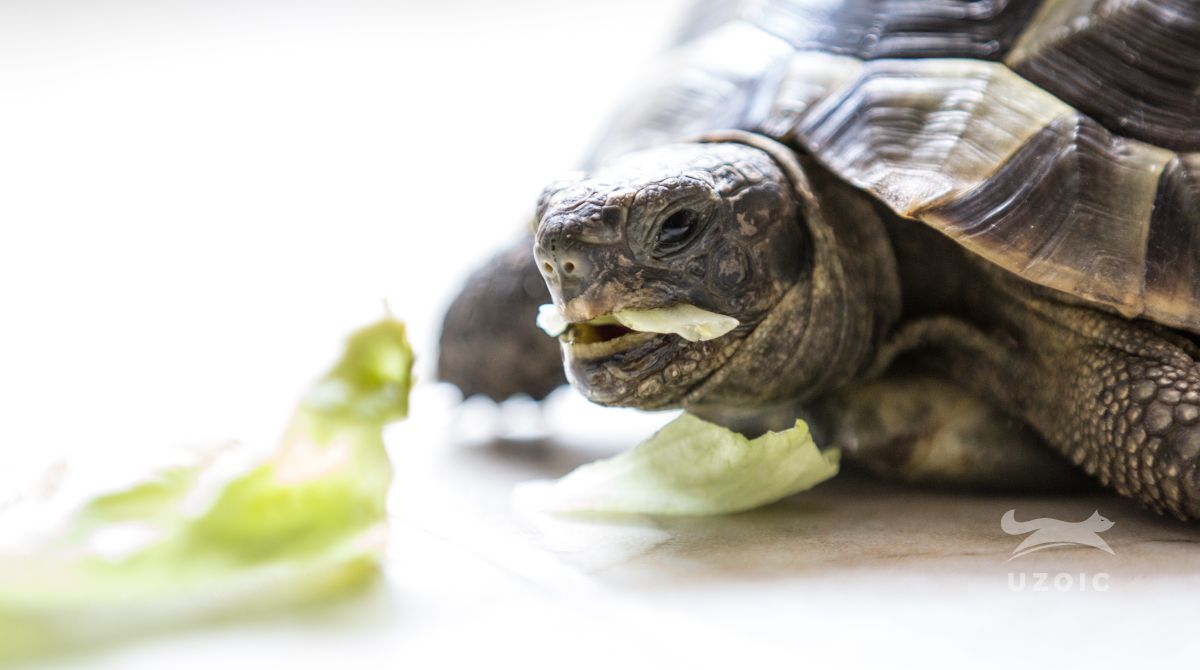So you just brought home a new tortoise, and you’re excited to have them join your family. But there’s one problem: your new Tortoise isn’t eating.
As a pet parent, it can be concerning when you bring home a new tortoise, and it stops eating. Many pets go through this phase when there is a change in environment, and it holds for tortoises as well.
So you are rightfully concerned when your new tortoise is not eating. There can be many underlying reasons why your new tortoise is not eating anything that you offer it.
Table of Contents
Why Is My New Tortoise Not Eating?
Your new tortoise is not eating because of its unsuitable habitat. Tortoises don’t like frequent changes to their habitat, and if you have just brought them home, they may not be used to the new environment.
As a result, your tortoise has stopped eating. This issue usually resolves on its own in a few days as the tortoise gets used to the new place.
While there are other reasons why your tortoise may not eat such as health issues, but these are less common.
If your tortoise has also given up drinking water, it is time for a vet checkup. Water is extremely important for your tortoise. Without hydration, a tortoise will get sick and die.
So, if the tortoise has given up drinking water as well, it is best to seek professional assistance and a thorough check-up to identify or rule out any serious health issues that might be troubling your new friend.
Tortoise Not Eating Due To New Environment
Your Tortoise may not be eating because it’s still adjusting to the new environment. This is perfectly normal.
It can take some time for tortoises to get used to their new homes, and during this adjustment period, they may not have much of an appetite.
Try to give your Tortoise some time to settle in, and offer small meals frequently throughout the day. With time, your Tortoise should start to eat more regularly.
Food is not appealing
Another reason your Tortoise may not be eating is that the food you’re offering isn’t appealing to them.
Tortoises are omnivorous, so they require a diet that includes plant and animal matter.
If you’re only offering one type of food, try adding variety to see if that makes a difference.
You can also experiment with different textures and temperatures – some tortoises prefer their food to be soft, while others like it to be crunchy.
Tortoise Not Eating Due To Stress
Many Tortoises stop eating when they are stressed. Tortoises are sensitive animals, and they can become stressed by changes in their environment or routine.
Stress is a common reason why tortoises may not eat. If your Tortoise is feeling stressed, they may not have an appetite.
Try to create a calm and relaxed environment for your Tortoise, and avoid handling them too much.
With time and patience, your Tortoise should start to feel more at ease and be more likely to eat.
How do I know if my Tortoise is stressed or unhappy?
Several signs may indicate your Tortoise is stressed. These include:
- Hiding more than usual
- Shell gaping
- Yawning
- Stretching out the neck
They will stop eating, be sad, and may snap at you or anyone trying to pet them.
On the other hand, a happy tortoise has an excellent appetite and goes about doing daily activities with interest.
If you notice any of these behaviors, it’s important to take steps to reduce stress in your Tortoise’s environment.
Doing so will help your Tortoise feel more comfortable and increase the likelihood that they will start eating again.
Sickness
Your new tortoise may not be eating because it is sick. Check below for common health issues:
Stomatitis is a common mouth infection that can cause your Tortoise to stop eating. Take your Tortoise to a vet if you notice swollen lips or red lesions in its mouth.
Respiratory infections are another common health problem in tortoises, and they can also lead to a loss of appetite. If you notice your Tortoise has mucus coming from his or her nose, or if he or she is making wheezing or clicking sounds when breathing, take it to a vet for check up.
Intestinal parasites are another health concern that can cause your Tortoise to stop eating. If you notice your Tortoise has diarrhea, vomiting, or a loss of appetite, it’s important to take him or her to the vet for treatment.
Uncomfortable Environment
Temperature is another factor that can affect your Tortoise’s appetite.
Tortoises are cold-blooded animals, so their body temperature depends on the temperature of their environment. If the temperature is too low, your Tortoise may not have an appetite.
Therefore, it’s important to keep your Tortoise’s habitat at the proper temperature to ensure they are comfortable and have a healthy appetite.
Hibernation
One of the most common reasons tortoises don’t eat is because they’re emerging from hibernation.
Hibernation is a natural process that allows tortoises to survive the winter months when food is scarce.
During hibernation, tortoises slow down their metabolism and go into a state of dormancy.
Then, when spring arrives and temperatures start to rise, tortoises gradually wake up and move around again.
As tortoises emerge from hibernation, they may not have an appetite for several weeks. This is normal and should not be a cause for concern.
However, it’s important to make sure your Tortoise has access to food and water so he or she can rehydrate and replenish energy stores.
Dehydration
Dehydration is another common reason why tortoises don’t eat. Tortoises are desert animals, so they’re adapted to living in dry environments.
However, this also means they’re susceptible to dehydration if they don’t have access to water.
If your Tortoise isn’t drinking enough water, he or she may become dehydrated and lose the desire to eat.
Dehydration can also lead to other health problems, such as shell rot and respiratory infections. Therefore, it’s important to make sure your Tortoise has access to fresh water at all times.
You should also take your Tortoise to the vet if you suspect he or she is dehydrated.
Do Tortoise Actually Drink Water?
Yes, tortoises drink water! It is a popular belief that Tortoise actually does not drink water but this is far from truth. They do drink water and they need to drink water.
If you see your Tortoise not eating and looking lethargic, it is possible that he/she is dehydrated and needs water.
Try giving your Tortoise some water and see if there’s any change.
Importance of Water For Tortoise
One common misconception about tortoises is that they do not need to drink water. However, this is not true.
Tortoises need to drink water, and they will often seek out water sources such as ponds and streams.
While they may not drink as often as other animals, they still need to consume water regularly to stay healthy.
Without adequate hydration, a tortoise can become dehydrated and may eventually die. So, while they may not be known for their love for water, tortoises actually need to drink it to survive.
What happens when a new tortoise is not eating?
New Tortoise not eating or losing appetite is usually a sign that something is wrong.
If the Tortoise does not find the environment and nutrition favorable, they may slow down their metabolism to conserve energy.
New tortoises may also not eat due to stress from the new environment. Causes of appetite loss include problems with the digestive system and incorrect temperature or humidity levels.
If you suspect that your Tortoise is not eating due to one of these issues, make sure to consult with a veterinarian or reptile specialist.
If you notice your new Tortoise is not eating, check for above common problems.
How do I get my new Tortoise to eat?
If the Tortoise is healthy, there are a few things that can be tried to encourage eating.
One is to offer a variety of foods, as some tortoises may be picky eaters.
Another is to mimic the natural environment as closely as possible, as this can help to trigger the appetite.
Finally, it is important to avoid overfeeding, as this can lead to digestive problems.
The easiest way to get your new tortoise to eat is by addressing some common problems. Thankfully, it is easy to fix these issues and get your tortoise eating in no time. So let’s go through some of the things you can do to help your tortoise’s appetite.
Change the habitat
First and foremost, you must identify whether the problem lies with the habitat.
Many first-time tortoise owners make this common mistake and put the tortoise to live in a small vivarium which may not be suitable for the tortoise.
We advise you to look for a tortoise habitat (also called tortoise table) which will have the most suitable environment for your tortoise to thrive.
Depending on the size of your tortoise, make sure the tortoise table is at least 40 inches long and 24 inches wide for a large tortoise.
Temperature
Check the temperature of their habitat. Tortoises are ectothermic animals meaning that they cannot regulate their body temperature and will lose their appetite if their habitat or enclosure is too cold.
Therefore, you must set up appropriate heating in the habitat to make it more suitable for the tortoise.
A tortoise’s habitat will usually require a heat lamp, preferably UVB, giving 10 to 12% UVB light and heating around 93.2 degrees Fahrenheit.
Lack of adequate heating also creates a problem with the production of Vitamin D3 in tortoises so take note of this requirement.
Ventilation
A tortoise may stop eating if it feels suffocated. So, make sure their habitat is well ventilated.
Once you have sorted out the living space for your new tortoise, give it some time to adjust to the new setting. It will just love the new home as it gives them sufficient space to walk around and relax.
Adjust the food that you are feeding
Next, slowly start feeding them their favorite food in small quantities and see how they react. Most tortoises will start eating once they are satisfied with their environment.
Follow the 80 – 20 rule to feed your tortoise correctly. This means 80% of the time; you should feed fresh veggies such as Kale, Collard Greens, Carrots, Cucumbers, Mustard, Dandelions, Celery, Bell Peppers, etc., and 20% of the time, you can feed fresh fruits such as Kiwi, Oranges, Melons, Berries, Grapes, etc.
After doing all this, if your tortoise continues not eating, it is best to seek out the help of a vet to identify underlying health issues.
It is possible that your tortoise is not feeling well due to a parasite or bacterial infection or an upset stomach. The vet can do a complete check up to identify the problem.
Infections can be treated quickly with some antibiotics, and your tortoise will start feeling better within a few days.
This will help your tortoise to regain its appetite and start eating again.
How long can a tortoise go without eating?
Tortoises can go a long time without eating. They are naturally built to survive in harsh conditions and can live very long. As per a study published by Nature, healthy tortoises can survive up to 3 years without food (but needs access to water).
This varies based on the species across the continents but on average; they can live without food anywhere between 6 months to 3 years.
How Do You Force Feed A New Tortoise?
We recommend that you do not force-feed a tortoise. Instead, follow the best practices listed regarding their habitat, and your tortoise will be back to eating its favorite veggies in no time!
Final Thoughts On Why Your Tortoise Is Not Eating
So, there you have it, the detailed low down on why your new tortoise is not eating and how you can help it.
Some of the top reasons for your new tortoise not eating, such as those related to habitat and environment, are easily fixable.
By following the tips given above, you should have a healthy and happy tortoise in no time!
Remember to seek out a vet’s assistance if you cannot get your tortoise to start eating after following these tips.
Tortoises can survive for long without food, but it is best to address the fixable problems as soon as possible.
This brings us to an end on this topic. We hope this blog post has helped you. Thanks for reading!
Also Read:
- Why Your Bearded Dragon Is Blowing Bubbles: Causes and Solutions
- Can Bearded Dragons Eat Clover?
- Do Leopard Geckos Need UVB?


